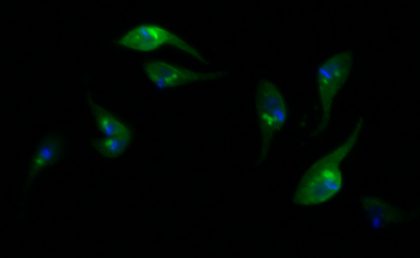How to easily apply computational methods to the identification of drugs against trypanosomatid-caused diseases
The latest Paper of the Month for Parasitology is Computational approaches for drug discovery against trypanosomatid-caused diseases
Neglected tropical diseases (NTDs) caused by trypanosomatid parasites such as American trypanosomiasis (Chagas disease), human African trypanosomiasis (sleeping sickness) and leishmaniasis affect millions of people worldwide, mainly in developing countries, and consequently produce a significant health, social and economic impact. No vaccinations for these diseases are available and the treatments are limited to a few drugs with low efficacy and serious side effects, highlighting the urgent need for the development of new therapies.
Different approaches have been implemented to identify new drug candidates. Traditional methods to find and optimize new chemical entities involve high-throughput screening, mainly based on chemical synthesis, and also bio-guided fractionation and isolation of natural products. However these procedures are usually time-consuming and require huge money investments. In this review we focus on computational methods applied to the identification of new drugs to treat trypanosomiasis and leishmaniasis.

Computational tools are very efficient to identify novel drug candidates or new indications for already-approved drugs for clinical use, a strategy known as drug repositioning or repurposing. In the case of NTDs, drug repurposing is recommended by the World Health Organization (WHO) since it reduces the drug development cost and time for its application in therapy and exploits the available information of the drugs, such as toxicity and pharmacokinetics parameters. In fact, WHO is currently applying this approach in the battle against the globally pandemic virus SARS-CoV-2, with antivirals and anti-malarial drugs as main candidates to be used as treatment.
Our review is focused on computational or “virtual screening” (VS) techniques, in particular those oriented to the macromolecular target or its ligands. Ligand-based VS consists on taking advantage of known ligands of a validated drug target in order to identify similar compounds that can bind and interfere with the macromolecule of interest. Common ligand-based techniques include fingerprint similarity, machine learning algorithms and ligand-based pharmacophores. On the other hand, receptor-based VS uses experimental data of the molecular structure of the drug target and applies molecular docking and structure-based pharmacophores approaches. Computational methodologies are easily accessible to any laboratory since a large number of free open source software and compounds databases are available. Many of these resources, and also instructions for use, tips and examples of their applications are detailed in our review.
Although the review focuses in the use of VS strategies for trypanosomatid-caused diseases, the described methods and recommendations are applicable to any other disease. We encourage all readers to try virtual screening for the rapid identification of potential drugs for further testing in experimental studies.
The article Computational approaches for drug discovery against trypanosomatid-caused diseases by Claudio A. Pereira, Melisa Sayé, Chantal Reigada, Ariel M. Silber, Guillermo R. Labadie, Mariana R. Miranda and Edward Valera-Vera is available free for a month.






